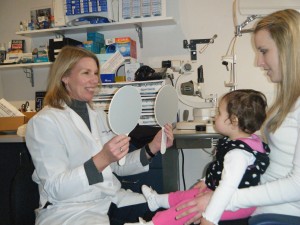There are many frame styles available to children, and it is much more acceptable to wear glasses than when I got my first pair decades ago. In fact it can be cool. Have you seen glasses for sale without a prescription?
Here are some tips when selecting glasses for kids.
- Frame – The frame should fit the face. The bridge is the part of the glasses that connects both the eye rims over the nose. Because most children do not have a fully developed or prominent nose, this area must be build-up or have nosepads to fit properly. The other frame feature that needs to fit is the temple. this is the part of the glasses that connects the front of the frame and fits over the ears. Proper sizing of the bridge and temples keep the glasses properly positioned on the face.
- Lenses – Polycarbonate lenses are generally the best for children. Polycarbonate lenses are impact-resistant, lighter in weight and have ultraviolet protection. If the prescription is for hyperopia (far-sightedness), an aspheric lens design will flatten out the lens and reduce magnification.
- Metal Sensitivity – Some children are sensitive to nickel. Fortunately there are alternative other frame materials such as titanium, stainless steel and plastic.
- Spring Hinges – Spring hinges provide flexibility and durability. This allows the temples to flex outward, away from the frame without causing any damage to the face or glasses.
- Appearance – It is very important that the child likes the glasses. Children’s frames come in many colors and styles. Make sure your child is happy with how the frame feels and looks.
- Eyeglass Case – When the glasses aren’t on the face, they should be in the case. Make sure your child’s eyewear includes a hard case to protect the glasses when carried in a backpack or put into a desk.
- Care and Cleaning – Parents need to show children how to maintain and clean their eyewear. the frame and lenses should be cleaned with a non-abrasive cloth using mild soap and water. Do not use paper products such as tissue. Don’t hesitate to come by the office if the frames needed adjusting, repair or just a little more cleaning.




 Children who do not have the necessary visual-motor and visual-perceptual skills to compete in the class room with their classmates, may act out, be easily distracted or not be able to pay enough attention to perform to their potential. A 15 year long study at the San Bernardino Juvenile Hall revealed that a much higher percentage of juvenile delinquents have vision problems than in the average population. According to the study by optometrists Stan Kaseno and Kristy Remick, poor visual skills can contribute to poor self-esteem, which can lead to poor attitudes and behavior in school. After a program that addressed the inmates problems, including vision and victim’s awareness classes, the repeat offender rate decreased from 90% to 15%.
Children who do not have the necessary visual-motor and visual-perceptual skills to compete in the class room with their classmates, may act out, be easily distracted or not be able to pay enough attention to perform to their potential. A 15 year long study at the San Bernardino Juvenile Hall revealed that a much higher percentage of juvenile delinquents have vision problems than in the average population. According to the study by optometrists Stan Kaseno and Kristy Remick, poor visual skills can contribute to poor self-esteem, which can lead to poor attitudes and behavior in school. After a program that addressed the inmates problems, including vision and victim’s awareness classes, the repeat offender rate decreased from 90% to 15%.




